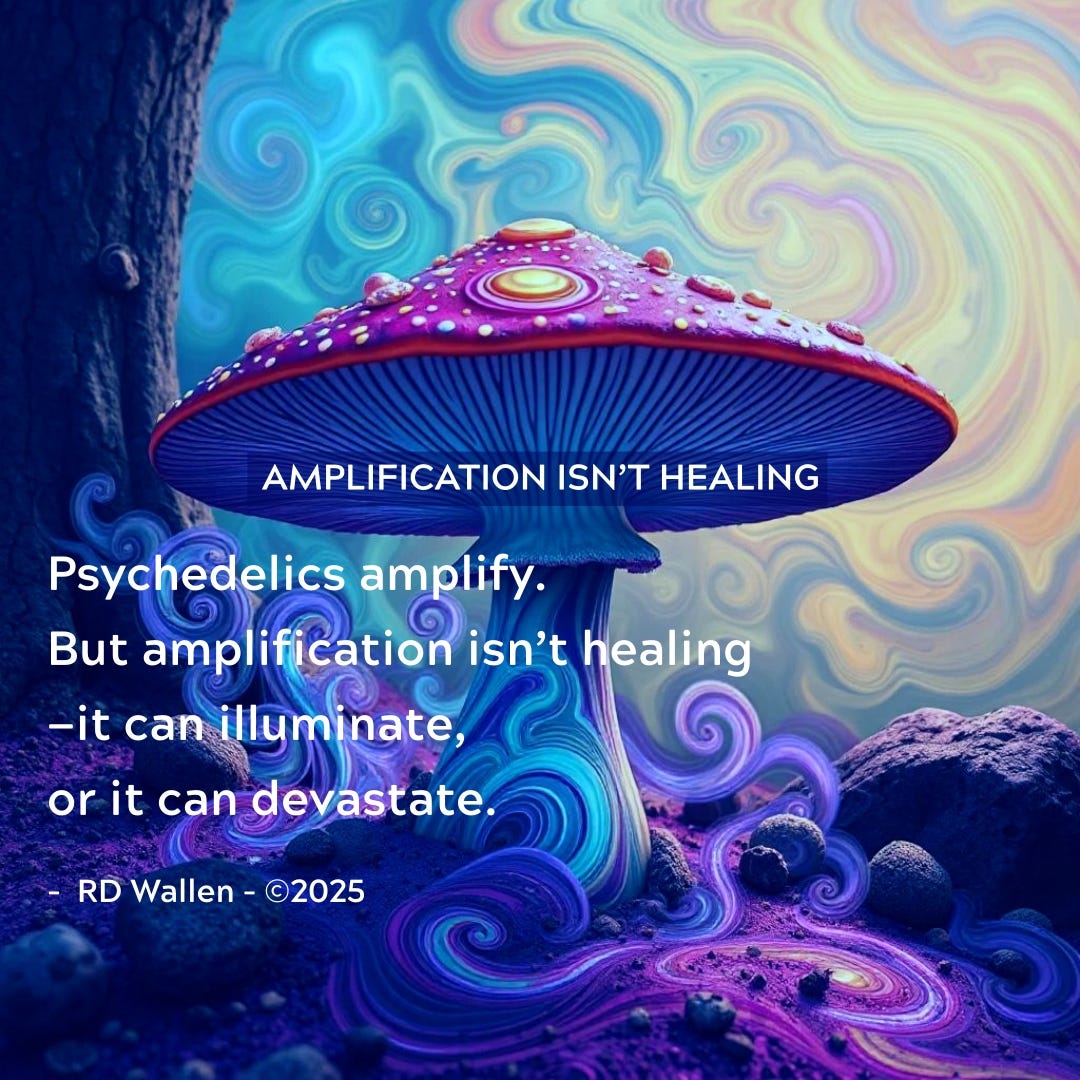WHEN PSYCHEDELICS RE-OPEN WOUNDS: Trauma, Memory, and the Limits of Set and Setting
Rus Devorah (Darcy) Wallen, LCSW, CIMHP
I was recently sent a preprint article (that just came late August from Research Square), titled “The Experience Of Recalled Trauma During Psychedelic Experiences and Perceived Links To Subsequent Extended Difficulties.” (Simon et al., 2025) The title alone caught my attention. As a trauma-informed clinician, I am no stranger to the promises and perils of psychedelic therapy, (see: PLANT MEDICINE AND HEALING CEREMONIES: UNCOVERING THE PROMISE, PERILS & PITFALLS) but reading this study left me both fascinated and deeply unsettled.
The researchers surveyed 608 people who had experienced psychological struggles lasting well beyond the psychedelic high. Astonishingly, over 40% linked their difficulties directly to resurfaced childhood trauma. These weren’t fleeting “bad trips.” They were experiences that lodged in the psyche, with ripple effects lasting months, sometimes longer. When the authors went deeper, conducting interviews with 18 participants, the findings came alive in a way that statistics cannot.
Stories from the Study
One participant (P5) described a moment of shattering revelation:
“The ayahuasca, just the entire trip, was like, yeah…your father sexually abused you. It was just like 100%. It put my entire life in context… Every single thing made sense after that.”
Another (P1) spoke of somatic flooding that mirrored the original wound:
“It really kind of replicated that trauma experience of like—shit goes very bad, very sideways. I barely survived it, and now I’m back.”
Others were left in a fog of uncertainty. Participant P3 confessed:
“I can’t trust it. I don’t know if that was real… not having closure about it was harmful for me and my family.”
And still another participant reported lingering aftershocks:
“I didn’t cope well after it… I had a lot of problems with sleep, and I was having flashbacks.”
The numbers told the story starkly: 39% described direct trauma re-experiencing, 22% symbolic or bodily re-embodiment, 50% fragmentation and confusion. About half eventually found some meaning or healing. But 28% reported mixed outcomes, and nearly a quarter—22%—were outright retraumatized, left worse off than before.
The Allure—and the Limits—of Set and Setting
Much of the psychedelic world repeats a caveat: “set and setting.” Set refers to mindset - your emotional state, intentions, expectations before the journey. Setting refers to the physical and social environment, the room, the music, the presence of a guide. Set and setting do matter, very much. A supportive, calm environment is far safer than a chaotic party where others are tripping. But the findings of this study challenge the notion that set, and setting are protective enough. Even in carefully structured environments, trauma emerged, overwhelmed, and destabilized. Trauma, by its nature, is unpredictable. You cannot always curate your way around it.
Read the pdf HERE (or click on the image blow. Produced by Neshamos.org)
What Happens in the Brain
The science explains why.
Default Mode Network (DMN): Psychedelics quiet the DMN, the network that gives us a stable sense of self and suppresses overwhelming memories. With the DMN dialed down, buried memories and sensations can flood into consciousness.
Memory Reconsolidation: Each time we recall a memory, the brain re-stores it. In therapy, if we recall a trauma while regulated, the memory can reconsolidate with less fear and attached. But under psychedelics, the intensity can push the memory back into storage with more fear, an amplification, possibly embedding it more deeply.
Neuroplasticity Windows: Psychedelics open a window of heightened plasticity. That’s part of their therapeutic promise that the brain become more flexible. But if trauma is re-experienced in a state of chaos, that very plasticity can etch the fear deeper. It’s like pouring cement while there is foot traffic.
This is why the same drug that helps one person feel free, and able to move forward with their issues, can leave another person feel fragmented, and even more distressed.
Trauma Therapy: A Different Path to Memory
In contrast, trauma therapies have developed careful methods for working with overwhelming memory.
EMDR (Eye Movement Desensitization and Reprocessing), pioneered by Francine Shapiro, uses bilateral stimulation while guiding the client to revisit traumatic material. The therapist ensures the client stays anchored in the present. If distress spikes, the session slows or pauses. The therapist is able to maintain safety.
Somatic Experiencing, developed by Peter Levine, emphasizes titration. During the sessions, the experience touches the trauma in tiny doses. Then returning to calm, the body learns to tolerate fragments of the memory without beoming overwhelmed.
Internal Family Systems (IFS), created by Richard Schwartz, helps clients “unblend” (IFS lingo) from traumatized parts of the ‘self.’ The client observes their inner world with curiosity about the various parts, rather than drowning in it.
Havening Techniques, developed by Ronald Ruden, use gentle touch (stroking arms, hands, or face) combined with visualization and distraction. This generates delta brainwaves and neurochemical safety signals, while doing “passive parallel activities” (such as a visualization, counting, easy mind games, humming, etc.) allowing the memory to be reconsolidated in a calmer state.
The common thread is pacing and safe containment. These therapies dip into memory and then return to safety. They give the nervous system time to metabolize. Psychedelics, by contrast, can kick the doors open and flood the room before the person is ready, retraumatizing the individual with great amplification.
The Amplifier Effect
This is the paradox of psychedelics. They can surface material that might otherwise remain locked away. That’s precisely why researchers are exploring them for PTSD. But amplification is not inherently healing. It can illuminate or it can devastate. Trauma therapy is like tending a fire. You add twigs slowly, keeping the flame alive without letting it flare out of control. Psychedelics can be like pouring gasoline onto the fire. Sometimes it produces brilliance and warmth. Sometimes it burns down the camp.
A Cautionary Hope
The Research Square study is a critical reminder. Psychedelics are not inherently therapeutic. They are amplifiers. For trauma survivors, amplification can just as easily re-open wounds as it can heal them. If psychedelics are to play a safe role in trauma treatment, their protocols must borrow from what trauma therapies already know: titration, pacing, containment, grounding. Trauma cannot be healed by force. It can only be metabolized with care. Until then, psychedelics remain a double-edged sword—part medicine, part minefield. "Psychedelics amplify. But amplification isn’t healing—it can illuminate, or it can devastate."
References
Levine, P. A. (1997). Waking the tiger: Healing trauma. Berkeley, CA: North Atlantic Books.
Ruden, R. (2019). The neurobiology of trauma and the treatment of trauma with havening. London: Routledge.
Schapiro, F. (2001). Eye movement desensitization and reprocessing: Basic principles, protocols, and procedures (2nd ed.). New York: Guilford Press.
Schwartz, R. C. (1995). Internal family systems therapy. New York: Guilford Press.
Simon, G., Tadmor, N., Skragge, M., Evans, J., & Robinson, O. C. (2025, August 21). The experience of recalled trauma during psychedelic experiences and perceived links to subsequent extended difficulties: A mixed-methods study (Preprint). Research Square. https://doi.org/10.21203/rs.3.rs-7255362/v1
van der Kolk, B. A. (2014). The body keeps the score: Brain, mind, and body in the healing of trauma. New York: Viking.




